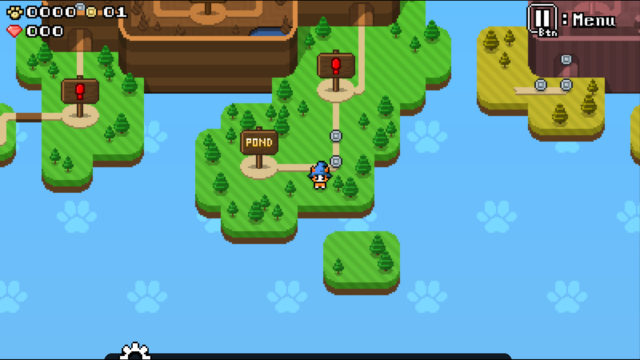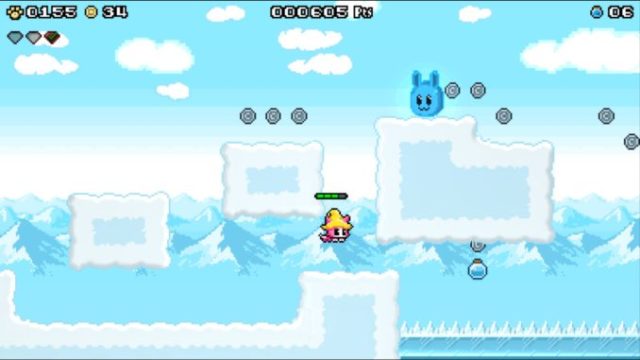Classic platformer with a few wrinkles thrown in; cool retro/anime vibe; great price
Not a lot in the way of a tutorial or explanation; probably too hard for most kids
No genre may be more synonymous with Nintendo systems than the platformer. Yes, we’ve got adventure games, from Zelda to Metroid, racers like Mario Kart, and RPGs like Pokémon, but, in the end, it’s all really about Mario. From the Super Mario Bros. trilogy on NES to the current hit on Switch, running and jumping are central to the Nintendo experience. MagiCat is such a platformer. A multiplatform title, the game recently made its way over to Switch after a year of being out on PC (Steam). It currently retails for $4.99 on both, which makes it one of the more inexpensive games on Nintendo’s console.
To the surprise of probably no one, MagiCat isn’t exactly heavy on story. At the beginning, you learn that a cat wizard has been robbed by some other animal and now has to get the stolen artifact-thingy back. This is all just window dressing for dropping players into an overworld reminiscent of Super Mario Bros. 3 or Super Mario World. The player’s goal is pretty simple: go to new levels, beat them, and collect stuff along the way. The game offers a very basic introduction to the mechanics, but for the most part players will have to figure things out on their own. To be fair, none of it is insanely complicated, especially for any veterans of Mario, but it definitely takes a little time to figure out just how this platformer stands apart from others like it.

Take the stuff you collect. Most platformers have them, but this one has a few, and it takes a while to figure out what they do. First there’s the coins, which accumulate enough to give you cat lives (points accrued during each level also yield cat lives). The cat lives, in turn, allow players to respawn in-level or escape out of levels when needed. Then there are the potions, which basically act like MP and do not carry over from level to level. And finally, there are the diamonds, which are harder to find but which are the currency for purchasing upgrades and items at shops scattered around the game world.
There’s also the attacks. MagiCat can jump on enemies, shoot them with a magical attack, or use a cool dash attack, but you sort of have to figure all of that out for yourself. In addition, the dash attack consumes some of your MP, but the game doesn’t exactly tell you that, either. The game also doesn’t explain that the magic attacks do more damage than the jump attacks, or that the magic attacks can be tossed up, or that players can float a short distance by holding down the jump button. Again, these aren’t complex things, but most modern platformers usually have either an in-game tutorial, a manual, or even a screen showing controls. As of this writing, there are none of these… not even a FAQ online.

The levels, although standard in their general design, are very different from one another in actual implementation. On a broad level, each level consists of a few segments, including a boss at the end that is typically a beefed-up version of what you saw earlier in the level. Each segment has a checkpoint where players can save their progress and replenish health in exchange for 10 MP. But within that framework, the game keeps things very different. Each level has its own unique challenges, to the point where no two levels feel quite the same. In that regard, MagiCat does a good job of keeping things from getting stale.
There’s no question that the game has a cute vibe to it, from the retro graphics and sound to the cutesy level design, but that belies a game that is pretty hard. This reviewer turned his 10-year-old and 6-year-old — both reasonably experienced gamers — loose on this game, and except for the earliest levels, they were unable to complete them without dying. To be fair, the game does allow you to replay earlier levels, which can let players accumulate lives and make finishing levels easier, but it’s also clear that this is a game more aimed for veteran core gamers.
So what to make of MagiCat? It’s definitely a solid platformer with a lot of replay value, and at a cost that is very compelling. It’s also hard and it takes more time to figure the ins and outs than it really should. For players who love platformers and don’t want a game to hold their hands, look no further. For those who want a simple, kid-friendly experience, this probably won’t do it.
Nintendojo was provided a copy of this game for review by a third party, though that does not affect our recommendation. For every review, Nintendojo uses a standard criteria.




 ShareThis
ShareThis





